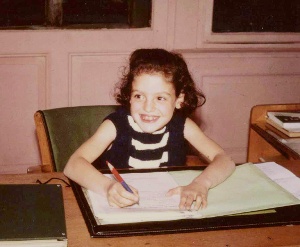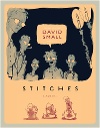Graphic Memoirs: Why We Read Them. Why We Need Them.
When a new graphic memoir comes out, I need to read it. I can’t get enough of people’s stories about their own lives — and I love comics. What an easy hunger to satisfy nowadays as the number of books in this genre — for all age groups — continues to grow. This proliferation proves that I am far from the only fan. But why do we enjoy graphic memoirs so much?
When a new graphic memoir comes out, I need to read it. I can’t get enough of people’s stories about their own lives — and I love comics. What an easy hunger to satisfy nowadays as the number of books in this genre — for all age groups — continues to grow. This proliferation proves that I am far from the only fan. But why do we enjoy graphic memoirs so much?
I have always felt an insatiable desire to know more about my fellow human beings. How they do things; how they handle their problems; what they think, feel, and value. When I was younger, I often imagined I could fly onto windowsills and observe, unseen, the lives of others. Graphic memoirs have fulfilled that desire perfectly.
 To be clear, a graphic memoir is an autobiographical story in comics format, or, as I like to describe the one I wrote, “a graphic novel of my life.” These types of tales invite me into private homes to participate in the lives of the narrators; to be right there with them, growing up around their parents and siblings, going to their schools, and dealing with their problems. I want to know big and little things about them, from what they have for breakfast to how they handle family dramas.
To be clear, a graphic memoir is an autobiographical story in comics format, or, as I like to describe the one I wrote, “a graphic novel of my life.” These types of tales invite me into private homes to participate in the lives of the narrators; to be right there with them, growing up around their parents and siblings, going to their schools, and dealing with their problems. I want to know big and little things about them, from what they have for breakfast to how they handle family dramas.
In a graphic memoir, the story line is what tells me the big things. It’s the images that tell me all the little things, in addition to making the setting so easy to grasp. No need for lengthy descriptions! (I remember so well my younger self’s delight with dialogue and action, and my annoyance at having to slog through descriptions.) My enjoyment of books, whether illustrated storybooks or comics, also included endless poring over the images, checking details in the scenery or the outfits.
For me, getting information through images rather than through words was — and still is — always more immediate and memorable. The experience of reading in comics form is, in that sense, more akin to that of watching a movie, but at one’s own pace. That is why I often read a graphic memoir twice. The first time, I am captivated by the main flow of the narrative. I want to know how everything will turn out. I gulp the story down. The second time, I read slowly. I spend time with the images and discover details in the art: a particular facial expression; an item in the background; the furniture; the clothes; a recurring tidbit I missed on first reading; a gesture or expression that makes sense now that I know the whole story.
I get a thrill of recognition in coming upon a familiar-seeming detail — oh, just like me! — or a feeling of awe about habits or customs different from my own — how interesting, how others do this! — and both feelings are comforting. They tell me that the world is full of things you are used to and also full of new things, and that it is all good.
* * *
For children in particular, graphic memoirs are such an effective means of exposure to other people, ways, and circumstances. Of course, reading any kind of book can offer an introduction to potentially unfamiliar lives and customs. When the story is autobiographical, however, that reality is even more tangible: the reader knows they are reading about a real life, a real experience. They can even, once finished with the book, do some research into the author to possibly find out what happened next.
Within the differences I’ve encountered in my reading, there are similarities to other people: recognizable needs, desires, habits, emotions, thoughts, reactions. These similarities to their own experiences can help readers enter the pages of a book, and the differences can open their minds to the sheer variety of human lifestyles and behaviors.
All too often, we hear of children mocking a “different” peer. Maybe their skin color or accent differs from that of their classmates, or unfamiliar food is coming out of their lunchbox. Maybe they have parents with uncommon professions or are being raised by grandparents. Maybe they are differently abled. Maybe they prefer to draw or read while their classmates enjoy playing sports. By being exposed to the personal voices of so many who feel or have felt different, more and more children, even if they are accustomed to homogenous environments, will increase their understanding of just how normal differences are.
* * *
So many books for young readers feature the universal feeling of wanting to fit in despite differences. After all, who among us has not felt out of place at one time or another?

The author as a child at her father's desk. Photo: Maurice Kantorovitz.
I certainly did as a child. I was born in Morocco and grew up in France, and I was of a different religion than my classmates. I so wanted to conform, to be like the others! Being different generated such anxiety. Now in my sixties, I still find comfort when I read about others who have felt that way.
It is also comforting to see experiences reflected from my adulthood. I settled in the United States in my twenties. I am fortunate that the decision to move was mine, that I had some support, that I spoke enough English to get by. Nevertheless, I am particularly fond of reading personal stories of people who also were not born here. Who grew up with habits from another part of the world, and maybe didn’t speak English at first.
These types of stories are vital to a culture of acceptance. They talk of obstacles, hardships, sacrifices, injustices; of courage and success; of overcoming hurdle after hurdle. But they also talk of families, of love, of hopes, of dashed expectations, of failing and trying again. Reading these stories, we can put our own lives in perspective. We can evaluate our problems more realistically and appreciate what we do have. These stories can help create and increase the amount of empathy in our midst.
When they’re told in graphic format, the visuals make the commonalities especially striking: no matter the circumstances, the skin color, or the country, a child’s body language is the same, hopeful eyes look the same, a character stricken by grief — or pain, or fear — will look and hold themself the same way. We can realize that we all are searching for the same things: happiness, acceptance, safety for ourselves and our loved ones, decency, peace.
Obviously, a memoir is based on memories. Are these memories exactly factual? To me, it doesn’t really matter. What I want is the narrator’s story filtered through their core: what stayed with them, what their mind chose to remember. Themes emerge. Authors make choices among the issues they had to face and how they faced them. These can range from feelings of not conforming, to unkind friends, to physical ailments, to neglectful parents, to escaping a war-torn country. No matter how serious or minor-seeming the struggles, readers want to know how the narrator handled their problems; we want to know how they felt; we need to hear that they survived, that they found solutions. Because we also have problems. What life doesn’t? And we want to know that we will also survive our hurdles.
When we read a graphic memoir, we hold in our hands the tangible proof that the author made it. They were able to write — and usually draw — their story. They were able to find a publisher for it. No matter what troubles they deal with through the pages of the book, we know they are all right now. And we can think: “We’ll be all right, too.”
Recommended Graphic Memoirs









From the March/April 2022 issue of The Horn Book Magazine.

RELATED
ALREADY A SUBSCRIBER? LOG IN
We are currently offering this content for free. Sign up now to activate your personal profile, where you can save articles for future viewing.















Add Comment :-
Be the first reader to comment.
Comment Policy: